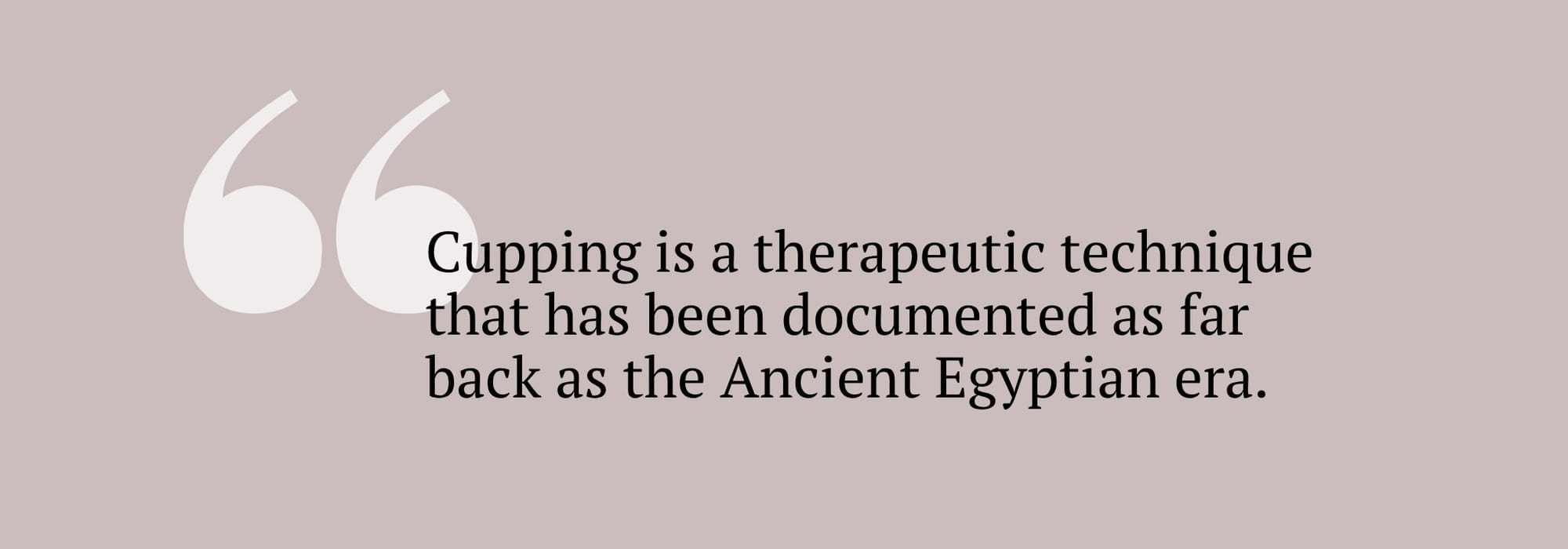If you’re one of the estimated 28 million people in the UK who experience chronic pain, then this ancient therapy could offer some relief
If you’ve been living with persistent pain, and conventional treatments aren’t giving you the relief you need, you might be curious about alternative therapies. One ancient practice that’s worth exploring is cupping therapy. But what exactly is cupping, and could it offer you some much-needed respite from chronic pain?
What is cupping?
Cupping is a therapeutic technique that has been documented as far back as the Ancient Egyptian era. It involves the application of small, cup-shaped vessels (normally made of glass, plastic, or silicone) on the skin’s surface to create a vacuum. The idea is to target specific areas of pain, such as the lower back, calves, or neck, to stimulate metabolic activity, improve immune function, and stabilise blood biochemistry.
There are several types of cupping, but they are largely separated into either ‘wet’ or ‘dry’. The former is an invasive treatment that involves applying suction, then afterwards, making tiny incisions on the surface of the skin before reapplying the cups to draw out a small amount of blood. Because there is less research into the efficacy of wet cupping, we’ll be focusing on the benefits of dry cupping.

How cupping might help chronic pain
A 2023 study published in the journal Frontiers aimed to collect and analyse all existing evidence of dry cupping therapy for pain. The researchers concluded that cupping therapy “appears to be a promising treatment modality for various pain-related disorders”. They emphasised that while it’s effective in the treatment of chronic pain, knee osteoarthritis, lower back pain, neck pain, chronic back pain, and shingles, the quality of the evidence supporting these outcomes is mostly low quality, with moderate-quality evidence less available.
Yet the evidence does help us build a picture of why people report pain relief as a result of cupping, showing that it increases blood circulation, activates the immune system, and stimulates nerve fibres, leading to a reduction in pain.
Cupping theory
The researchers found that gentle suction increases blood flow and oxygen to the treated area, drawing blood toward the skin’s surface, encouraging the release of substances that act as your body’s own natural painkillers. This could explain why many people report feeling less discomfort, and more relaxed, after a cupping session.
While it’s always worth speaking to your GP first with regards to chronic pain treatment, and more research is needed, dry cupping could be an inexpensive, non-invasive, and low-risk (if performed by a trained practitioner) therapeutic modality, to use alongside your ongoing medical treatment.
But doesn’t it hurt?
You would be forgiven for assuming that cupping is a painful therapy, especially if you’ve seen the deep purple circles that are often left behind on the skin when cups are removed. While you may feel a tight pulling sensation as the cups are applied, it should otherwise be relatively painless. And those eye-catching circular marks? They’re not like a typical bruise caused by an injury, so they shouldn’t hurt.
What to expect from dry cupping therapy
Cupping is performed by a massage therapist or physiotherapist, who will typically offer an initial consultation before any treatment goes ahead. This is the perfect opportunity for you to open up about your chronic pain symptoms, explaining which points of your body, you’d like to work on, as well as communicating any other underlying health issues. Based on your needs and preferences, the therapist will be able to determine where exactly to place the cups on your body, as well as what techniques might work best.
Each therapist will have their own preferences for how they work with the cups, for example, some may opt for glass cups with flame suction, while others use modern silicone or plastic cups with manual pumps. The duration can vary, too – some therapists keep cups in place for five to 10 minutes, while others may use a sliding technique, moving the cups across oiled skin.
Although cupping is considered low risk, people who are pregnant or have metastatic cancer, muscle spasms, bone fractures, anaemia, blood clotting problems, seizures, skin conditions, or a history of strokes, should avoid cupping.
Can I try cupping at home?
While cupping kits are available for home use, it’s recommended you experience the therapy with a qualified practitioner before attempting any DIY treatments. A trained professional can tailor treatment to your individual needs, ensure proper cup placement, and monitor your response. If you do decide to try cupping at home after professional guidance, invest in a quality kit with clear instructions, start with gentle suction, and never leave cups on for longer than recommended.
I spoke to Jillian, 46, from Glasgow, who says: “I have fibromyalgia, and I first tried cupping when my massage therapist suggested using it to specifically address back pain. I trusted her as I’d been going for years, so decided to give it a go.
“There was a slight tightness when the cup was put in place, but then it subsided, and I was left to lie on my front with the cups doing their thing on my back. I was super-impressed with the immediate relief I felt, and now, I can tell when specific body parts will benefit from having a cup on it for a few minutes.”

Jillian admits that cupping is just one aspect of her chronic pain management, which she uses alongside traditional treatment such as talking therapy, exercise, and pain medication. “I’ve invested in some silicone cups to use at home, and they are ideal for when I’m having a pain flare up. I know now that popping a cup on my back or hips for 10 minutes in the morning can be the thing that allows me to get out of bed some days.”
While cupping therapy shows promise as a complementary approach to managing chronic pain, it works best as part of a holistic treatment plan rather than a standalone solution. The evidence suggests it may offer real benefits, though more high-quality research is needed to fully understand its effectiveness.
The good news is that cupping is relatively safe, affordable, and accessible, when performed by qualified practitioners. For many people living with chronic pain, it has become a valuable tool – not a miracle cure, but a way to find relief on difficult days.


Comments